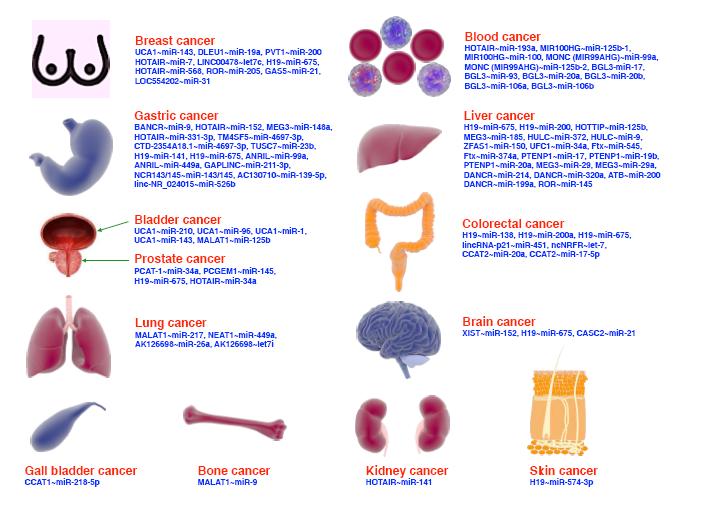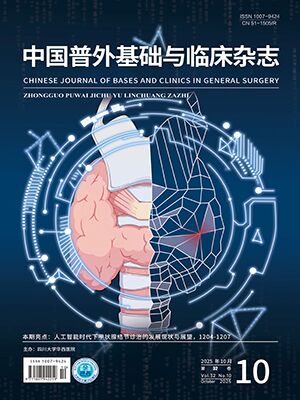| 1. |
Bray F, Laversanne M, Sung H, et al. Global cancer statistics 2022: GLOBOCAN estimates of incidence and mortality worldwide for 36 cancers in 185 countries. CA Cancer J Clin, 2024, 74(3): 229-263.
|
| 2. |
邬昊, 吕青. 全球及中国乳腺癌的流行病学趋势及防控启示: 2018–2022年《全球癌症统计报告》解读. 中国普外基础与临床杂志, 2024, 31(7): 796-802.
|
| 3. |
姚一菲, 孙可欣, 郑荣寿. 《2022全球癌症统计报告》解读: 中国与全球对比. 中国普外基础与临床杂志, 2024, 31(7): 769-780.
|
| 4. |
Chen JJ, Huang NS, Xue JY, et al. Current status of breast reconstruction in southern China: A 15 year, single institutional experience of 20 551 breast cancer patients. Medicine (Baltimore), 2015, 94(34): e1399. doi: 10.1097/MD.0000000000001399.
|
| 5. |
王佳妮, 欧开萍, 刘嘉琦, 等. 乳腺癌多学科综合诊疗模式的能力建设及发展趋势. 中国普通外科杂志, 2023, 32(5): 656-664.
|
| 6. |
刘瀛. 保乳术与改良根治术治疗早期乳腺癌的临床疗效分析. 中国普通外科杂志, 2014, 23(5): 709-711.
|
| 7. |
沈裕厚, 岳爱民, 尹宏达, 等. 肿瘤整形技术在乳腺癌保乳手术中的临床应用. 中国普通外科杂志, 2022, 31(5): 577-586.
|
| 8. |
De La Cruz L, Blankenship SA, Chatterjee A, et al. Outcomes after oncoplastic breast-conserving surgery in breast cancer patients: A systematic literature review. Ann Surg Oncol, 2016, 23(10): 3247-3258.
|
| 9. |
王晓文, 刘超, 欧江华. 单孔腔镜保乳术与开放保乳术治疗早期乳腺癌的疗效及安全性比较. 中华普外科手术学杂志(电子版), 2021, 15(5): 558-561.
|
| 10. |
Lai HW, Mok CW, Chang YT, et al. Endoscopic assisted breast conserving surgery for breast cancer: Clinical outcome, learning curve, and patient reported aesthetic results from preliminary 100 procedures. Eur J Surg Oncol, 2020, 46(8): 1446-1455.
|
| 11. |
Kimball CC, Nichols CI, Vose JG, et al. Trends in lumpectomy and oncoplastic breast-conserving surgery in the US, 2011–2016. Ann Surg Oncol, 2018, 25(13): 3867-3873.
|
| 12. |
Owaki T, Yoshinaka H, Ehi K, et al. Endoscopic quadrantectomy for breast cancer with sentinel lymph node navigation via a small axillary incision. Breast, 2005, 14(1): 57-60.
|
| 13. |
骆成玉. 腔镜技术在乳腺癌治疗应用及评价. 中国实用外科杂志, 2015, 35(7): 721-723.
|
| 14. |
Wan A, Liang Y, Chen L, et al. Association of long-term oncologic prognosis with minimal access breast surgery vs conventional breast surgery. JAMA Surg, 2022, 157(12): e224711. doi: 10.1001/jamasurg.2022.4711.
|
| 15. |
Gui Y, Chen Q, Li S, et al. Safety and feasibility of minimally invasive (laparoscopic/robotic-assisted) nipple-sparing mastectomy combined with prosthesis breast reconstruction in breast cancer: A single-center retrospective study. Ann Surg Oncol, 2022 Feb 16. doi: 10.1245/s10434-022-11420-8.
|
| 16. |
Takahashi H, Fujii T, Nakagawa S, et al. Usefulness of endoscopic breast-conserving surgery for breast cancer. Surg Today, 2014, 44(11): 2037-2044.
|
| 17. |
Lu S, Yang J, Wei T, et al. Single-incision endoscope-assisted breast-conserving surgery and sentinel lymph node biopsy: prospective SINA-BCS cohort study. Br J Surg, 2023, 110(9): 1076-1079.
|
| 18. |
Wang ZH, Ng HI, Teng CS, et al. Outcomes of single-port gasless laparoscopic breast-conserving surgery for breast cancer: An observational study. Breast J, 2019, 25(3): 461-464.
|
| 19. |
邱梦雪, 杨焕佐, 周娇, 等. 基于华西三号孔的腋窝入路腔镜乳腺良性肿瘤切除及恶性肿瘤保乳术技巧与疗效分析. 中国胸心血管外科临床杂志, 2023, 30(3): 350-356.
|
| 20. |
张晴, 谢妍妍, 梁法清, 等. 腔镜和机器人手术在乳腺疾病治疗中的前世今生. 中国修复重建外科杂志, 2024, 38(7): 769-775.
|
| 21. |
谢妍妍, 吕青, 杜正贵. 乳腺腔镜和机器人手术的现状及未来之路—华西医院经验分享. 外科理论与实践, 2022, 27(5): 396-402.
|
| 22. |
Ueda S, Tamaki Y, Yano K, et al. Cosmetic outcome and patient satisfaction after skin-sparing mastectomy for breast cancer with immediate reconstruction of the breast. Surgery, 2008, 143(3): 414-425.
|
| 23. |
Harris JR, Levene MB, Svensson G, et al. Analysis of cosmetic results following primary radiation therapy for stages Ⅰ and Ⅱ carcinoma of the breast. Int J Radiat Oncol Biol Phys, 1979, 5(2): 257-261.
|
| 24. |
万安弟, 周于钦, 张聪, 等. 腔镜与开放保乳手术治疗早期乳腺癌的近期疗效比较. 中国普通外科杂志, 2023, 32(11): 1743-1751.
|
| 25. |
刘义粉, 尹长恒. 开放保乳术与单孔法腔镜保乳术治疗早期乳腺癌的疗效及对患者生存质量的影响. 实用医学杂志, 2019, 35(17): 2770-2774.
|
| 26. |
牛增志, 张玉洁, 杨明军, 等. 单孔法腔镜保乳术和开放保乳术治疗早期乳腺癌的疗效及患者对乳房外观的影响. 癌症进展, 2024, 22(12): 1363-1366.
|
| 27. |
Xie F, Wang ZH, Wu SS, et al. Comparing outcomes of single-port insufflation endoscopic breast-conserving surgery and conventional open approach for breast cancer. World J Surg Oncol, 2022, 20(1): 335. doi: 10.1186/s12957-022-02798-6.
|
| 28. |
杜正贵, 李田园, 梁法清, 等. 腔镜乳腺癌手术应用现状及展望. 中国实用外科杂志, 2024, 44(11): 1206-1210.
|
| 29. |
Ozaki S, Ohara M, Shigematsu H, et al. Technical feasibility and cosmetic advantage of hybrid endoscopy-assisted breast-conserving surgery for breast cancer patients. J Laparoendosc Adv Surg Tech A, 2013, 23(2): 91-99.
|
| 30. |
Clough KB, Kaufman GJ, Nos C, et al. Improving breast cancer surgery: a classification and quadrant per quadrant atlas for oncoplastic surgery. Ann Surg Oncol, 2010, 17(5): 1375-1391.
|




